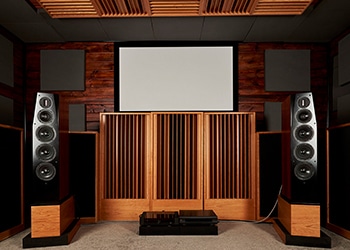In any home theater sound system, we must balance the number of channels with the room size and volume. We must make sure we are not placing too much energy within the room. All small rooms have acoustical issues that are exaggerated by placing too much energy into them. Low-frequency energy is the largest problem. We have three sound fields that we must address. We must balance the energy from sidewall to sidewall, front to rear wall, and floor to ceiling. Low-frequency energy in our home theater sound system will smother and blur everything including dialog and music. Low-frequency pressure will cause the room to “load” in certain places within the room. This loading process is produced by excessive energy within our rooms. We must match the number of sources to the room, so that we are not over producing energy that will not fit within our rooms.

Home theater sound systems are all about low-frequency energy. We have car crashes, explosions, jets flying overhead and a whole host of other noise generating systems. The sonics of the car crash and explosion must live and die on its volition. It can not overstay its welcome. When it does we have reverberation https://www.dictionary.com/browse/reverberation With high reverberation times sounds stay around longer than desired. When this occurs we have exaggeration of some frequencies and the elimination of others. We will be able to hear too much of one frequency band and not enough of the other. Low-frequency energy waves are long and tall. Any frequency below 125 Hz. will not fit in today’s small rooms. Most explosions and crashes generate energy in the 30 – 50 Hz. region. These waves of energy are 30, 40, and 50′ long in length. How can these energy waves fit within our 13 – 15′ room dimensions. The answer is that they can not and when they don’t fit, they excite the air between the room dimensions which produces modal issues.

Axial modes occur between two parallel surfaces. http://artsites.ucsc.edu/ems/music/tech_background/TE-02/modes/Modes.html . They can occur between the front and rear walls, both sidewalls, and the floor to ceiling dimension. Axial modes are the strongest of all modal issues. They can blur and smear middle and high frequencies where our dialog exists. Have you ever watched a movie within a small room and could not hear the dialog coming from the screen especially when there is a car crash or explosion? This is caused by excessive pressure which is trapped between the room boundary surfaces. The pressure levels are greater than the dialog, so they overpower the dialog with lower frequency energy issues. The next strongest modal issues are tangential modes. They occur between four surface areas. They can occur between the front and rear walls along with both sidewalls. They can also occur between the floor and ceiling and the sidewalls. Oblique modes occur between six surface areas. They are everywhere within our room. The axial modes are the strongest and most audible. The tangential modes are next and the oblique modes produce the least distortion.

In our home theater sound system, we must make sure we have the correct room size and volume to deal with the energy we will be placing within it. We also must match the number of channels we use in the room. Too many channels produce too much energy. Too much energy, too many modal issues. In order to deal with all of these modal issues, we must use the appropriate treatment type within the room to manage the energy. We have two major types of treatment. We have absorption and diffusion. Absorption is a technology that reduces the strength of the energy we place within the room. Absorption changes acoustic sound energy into heat thus reducing its strength. Diffusion is a technology to make smaller rooms sound larger. We use absorption for low, middle, and high frequencies. We use diffusion for middle and higher frequencies. In any home theater sound system, we must use a balance of both technologies. We use absorption for low frequencies and diffusion for middle and high frequencies. Absorption is the only treatment type that will tame the excessive energy created by long waves in our small rooms. Diffusion will spread the middle and high frequency energy out within our rooms so that to our ears and brain the room sounds larger than its physical dimensions.

C.A.W. Carbon Absorbing Wall: https://www.acousticfields.com/carbon-absorber-wall/
Diaphragmatic Absorption: https://www.acousticfields.com/product/acda-10-activated-carbon-diaphragmatic-absorber/
There are three types of low-frequency absorption technology. There are Helmholtz, membrane, and diaphragmatic. Diaphragmatic absorption is the most powerful of all three types. It is the only technology that has the horsepower to deal with the excessive low-frequency modal issues within our rooms. We have two options when it comes to treating the excessive low-frequency energy within our home theater sound system. We can build it into our walls or we can use freestanding units. It’s all about having enough surface area of coverage to deal with the frequency and amplitude of the modal issues at each wall location. Building the low-frequency management system in the walls freeing up space in our rooms With this inwall method, we do not have a lot of boxes sitting around taking up valuable space within our rooms. Quadratic diffusion is the only diffusion type that can create a diffuse sound field within our rooms. Quadratic diffusers can create a diffused soundfield in all directions within the room. In our home theater sound system diffusers should be placed on the ceiling and rear wall.
About Us At Acoustic Fields: https://www.acousticfields.com/about/







